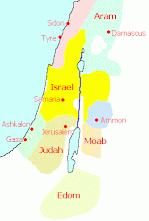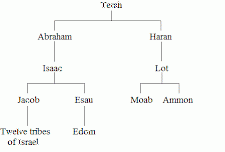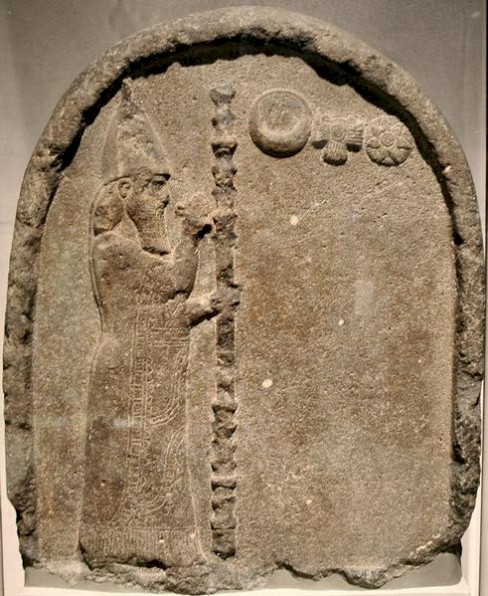Edomites
Q208475Edom: Iron Age kingdom, directly south of the Dead Sea, situated in modern Jordan and Israel. In Greek, it is called Idumea.
Bronze Age

The word Edom means "red" and is probably a reference to the colors of the Seir mountains east of the Wadi al-Araba. That the name was already used for a recognizable political unit in the Bronze Age, can be deduced from Egyptian texts. A document that has been quoted to prove this, is the fourteenth-century Amarna letter #256, which indeed refers to an URUÚ-du-mu. The identification with Edom, however, is almost certainly incorrect; the town of Udumu appears to have been east of Lake Galilee. There is less doubt about the reference to "the Šasu nomads from Edom" who, during the reign of Merenptah (r.1213-1203), were allowed to enter the kingdom of the Nile.note These nomads are mentioned in several other texts, which do not specifically connect them to Edom.
Nevertheless, the Šasu from Edom are interesting, because they not only illustrate that in the Late Bronze Age, there were nomadic Edomites, but also that there was nomadic exchange from the eastern to the western Sinai desert. The stories about Moses and the wandering Hebrews are situated against this background. It was only in the ninth and eighth centuries that the Edomites became, partly, sedentary.
Iron Age (Edom)
The Bible tells that king Saul waged war against the Edomites and that David gained supremacy over the Edomites.note A pro-Egyptian insurrection against David's son and successor Solomon is also recorded,note but from the Biblical remark that Solomon could send out ships to a country named Ophir, we may deduce that he regained control.note

It is only during the reign of Jehoram (r.848-842) that Edom is mentioned as autonomous,note but the kings of Judah did not accept its independence. For instance, King Amaziah (r.796-782) attacked and defeated the Elamites,note who appear to have been defeated by the Moabites as well.note Nevertheless, relations between Edom and Judah could also be cordial: the genealogies included in Genesis suggest that the authors of this part of the Bible believed that the Edomites and Israelites were closer related than the Israelites and Ammonites or Moabites.
In the eighth century, the Assyrians appeared on the scene. Adad-Nirari III (r.811-783) received tribute. In royal texts by Tiglath-pileser III (r.745-727) and Sennacherib (r.705-681), we encounter the names of Edomite rulers with names such as Qawsmalak ("the god Qaws is king") and Hairam. Esarhaddon (r.680-669), and Aššurbanipal (r.669-631?) were the overlords of king Qawsgabar ("Qaws is mighty").note A seal of the latter has been excavated at Umm el-Biyara in Jordan. As is well-known, the Assyrians conquered Israel (724 or 722) and reduced the other kingdoms in the area - Judah, Edom, Moab, Ammon - to vassal states. An Assyrian palace has been excavated in the citadel of Bozra, which may have been the seat of a garrison.

As Assyrian vassal, Edom had retained some of its independence, but when the Assyrians had been superseded by the Babylonians as leaders of the Near East (in the last quarter of the seventh century), things started to change. Judah was the first to be converted into a province: king Nebuchadnezzar did this in 587 and deported the Jews to Babylonia. In the fifth year, Ammon and Moab were annexed.note
It seems that during the Babylonian Captivity of the Jews, which is traditionally dated to 587-539, the Edomites looted Judah and settled in the northern Negev.note Maybe as a retaliation, Edom was invaded by the Babylonian king Nabonidus in 553;note he even proceeded further to the south, to the Arab town Tayma and beyond, eventually reaching Yatrib (modern Medina).
After Nabonidus' return, the Edomites expanded their power. The Jewish prophet Ezekiel implies that Edom was in control of Dedan, note an oasis 500 kilometers to the south. The situation remained unquiet after the Persians had taken power; the Arab tribe of the Nabataeans invaded Edom, and seized power.
Hellenistic Age (Idumea)
It seems that many Edomites moved to the newly acquired land in the northern Negev, because in the Hellenistic age (which starts with the conquests Alexander the Great in 333), the name "Idumea" refers to the Negev. The new capital was Hebron; other towns were Marisa and Beth-Sur. The Edomite homeland had been taken over by the Nabataeans, who repelled Greek attacks.note
As long as the Ptolemies, descendants of Alexander's general Ptolemy I Soter, controlled this area, the situation remained quiet, but they lost their Asian possessions to the Seleucids after the Fifth Syrian War (202-195). The Jews revolted against their overlords (the Maccabaean Revolt) and their leader, Judas, invaded Idumea in 167, sacking Hebron.note John Hyrcanus (r.134-104) subdued the Idumeans and forcibly converted them to Judaism.note
The Idumaeans were at first not accepted as Jews. King Herod the Great, who had an Idumaean father and a Nabataean mother, was not really considered to be a king of the Jews - although this had to do with his pro-Roman policies too. After the death of his successor Herod Archelaus, the kingdom was annexed and Idumaea was now part of the Roman province Judaea. If ethnic divisions still existed, they slowly disappeared, and during the great war against the Romans that broke out in 66/67, the Idumaeans fought with the Jews.note Their leader Simon bar Giora was one of the Jewish generals during the siege of Jerusalem.
After this war, Idumea disappears from our sources as an independent political unit. However, in rabbinical sources, the word "Edom" was a code name for Rome. This is a consequence of the following lines from Numbers:
I see him, but not now; I behold him, but not near. A star shall come out of Jacob and a scepter will rise out of Israel. It shall crush the foreheads of Moab and break down all the sons of Sheth. Edom shall be dispossessed.note
Since the second century BCE, these words have been interpreted as a Messianic prophecy; when Rome became a major player in the region, the interpretation of the last words was adapted to the situation.